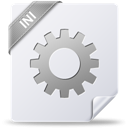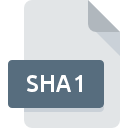
SHA1 File Extension
SHA-1 Hash Format
-
Category
-
Popularity4 (5 votes)
What is SHA1 file?
SHA1 is a file extension commonly associated with SHA-1 Hash Format files. Files with SHA1 extension may be used by programs distributed for platform. SHA1 file format, along with 6033 other file formats, belongs to the Misc Files category. The most popular program for handling SHA1 files is Windows Notepad, but users can choose among 4 different programs that support this file format. Windows Notepad software was developed by Microsoft Corporation, and on its official website you may find more information about SHA1 files or the Windows Notepad software program.
Programs which support SHA1 file extension
SHA1 files can be encountered on all system platforms, including mobile, yet there is no guarantee each will properly support such files.
Programs that support SHA1 file
How to open file with SHA1 extension?
There can be multiple causes why you have problems with opening SHA1 files on given system. Fortunately, most common problems with SHA1 files can be solved without in-depth IT knowledge, and most importantly, in a matter of minutes. The following is a list of guidelines that will help you identify and solve file-related problems.
Step 1. Get the Windows Notepad
 The main and most frequent cause precluding users form opening SHA1 files is that no program that can handle SHA1 files is installed on user’s system. This issue can be addressed by downloading and installing Windows Notepad or different compatible program, such as TextEdit, Text editor, NotePad++ text editor. Above you will find a complete listing of programs that support SHA1 files, classified according to system platforms for which they are available. If you want to download Windows Notepad installer in the most secured manner, we suggest you visit Microsoft Corporation website and download from their official repositories.
The main and most frequent cause precluding users form opening SHA1 files is that no program that can handle SHA1 files is installed on user’s system. This issue can be addressed by downloading and installing Windows Notepad or different compatible program, such as TextEdit, Text editor, NotePad++ text editor. Above you will find a complete listing of programs that support SHA1 files, classified according to system platforms for which they are available. If you want to download Windows Notepad installer in the most secured manner, we suggest you visit Microsoft Corporation website and download from their official repositories.
Step 2. Verify the you have the latest version of Windows Notepad
 If you already have Windows Notepad installed on your systems and SHA1 files are still not opened properly, check if you have the latest version of the software. It may also happen that software creators by updating their applications add compatibility with other, newer file formats. This can be one of the causes why SHA1 files are not compatible with Windows Notepad. All of the file formats that were handled just fine by the previous versions of given program should be also possible to open using Windows Notepad.
If you already have Windows Notepad installed on your systems and SHA1 files are still not opened properly, check if you have the latest version of the software. It may also happen that software creators by updating their applications add compatibility with other, newer file formats. This can be one of the causes why SHA1 files are not compatible with Windows Notepad. All of the file formats that were handled just fine by the previous versions of given program should be also possible to open using Windows Notepad.
Step 3. Assign Windows Notepad to SHA1 files
After installing Windows Notepad (the most recent version) make sure that it is set as the default application to open SHA1 files. The method is quite simple and varies little across operating systems.
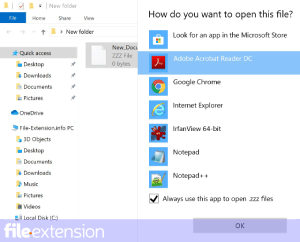
The procedure to change the default program in Windows
- Right-click the SHA1 file and choose option
- Select
- Finally select , point to the folder where Windows Notepad is installed, check the Always use this app to open SHA1 files box and conform your selection by clicking button
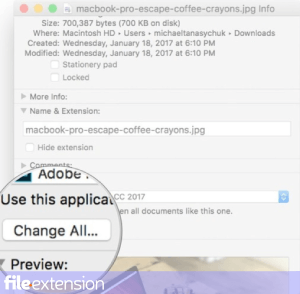
The procedure to change the default program in Mac OS
- From the drop-down menu, accessed by clicking the file with SHA1 extension, select
- Open the section by clicking its name
- From the list choose the appropriate program and confirm by clicking .
- A message window should appear informing that This change will be applied to all files with SHA1 extension. By clicking you confirm your selection.
Step 4. Check the SHA1 for errors
Should the problem still occur after following steps 1-3, check if the SHA1 file is valid. Problems with opening the file may arise due to various reasons.
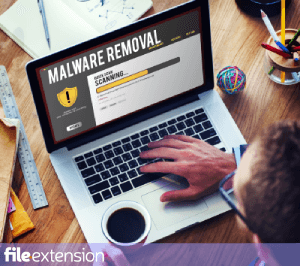
1. The SHA1 may be infected with malware – make sure to scan it with an antivirus tool.
If the SHA1 is indeed infected, it is possible that the malware is blocking it from opening. It is advised to scan the system for viruses and malware as soon as possible or use an online antivirus scanner. If the scanner detected that the SHA1 file is unsafe, proceed as instructed by the antivirus program to neutralize the threat.
2. Ensure the file with SHA1 extension is complete and error-free
If the SHA1 file was sent to you by someone else, ask this person to resend the file to you. During the copy process of the file errors may occurred rendering the file incomplete or corrupted. This could be the source of encountered problems with the file. When downloading the file with SHA1 extension from the internet an error may occurred resulting in incomplete file. Try downloading the file again.
3. Verify whether your account has administrative rights
Sometimes in order to access files user need to have administrative privileges. Log out of your current account and log in to an account with sufficient access privileges. Then open the SHA-1 Hash Format file.
4. Make sure that the system has sufficient resources to run Windows Notepad
If the systems has insufficient resources to open SHA1 files, try closing all currently running applications and try again.
5. Check if you have the latest updates to the operating system and drivers
Up-to-date system and drivers not only makes your computer more secure, but also may solve problems with SHA-1 Hash Format file. Outdated drivers or software may have caused the inability to use a peripheral device needed to handle SHA1 files.
Do you want to help?
If you have additional information about the SHA1 file, we will be grateful if you share it with our users. To do this, use the form here and send us your information on SHA1 file.

 Windows
Windows 


 MAC OS
MAC OS 
 Linux
Linux 
